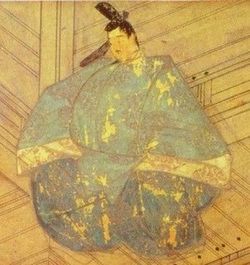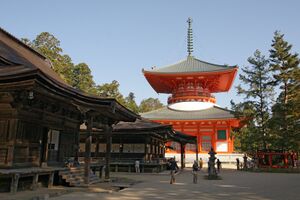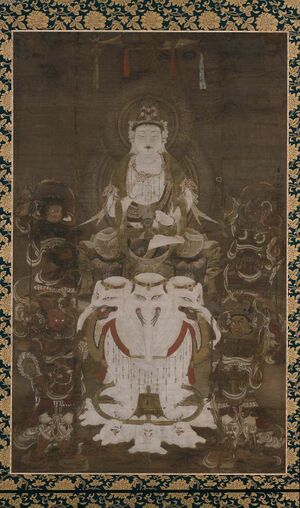فترة هـِيْآن
| جزء من سلسلة عن |
| تاريخ اليابان |
|---|
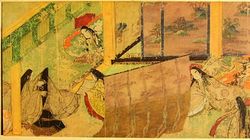 |
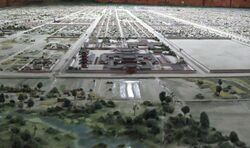
فترة هـِيـْآن (ياليابانية: 平安時代) مابين (794-1185 م.): من فترات التاريخ الياباني.[1] It followed the Nara period, beginning when the 50th emperor, Emperor Kammu, moved the capital of Japan to Heian-kyō (modern Kyoto). Heian (平安) means "peace" in Japanese. It is a period in Japanese history when the Chinese influences were in decline and the national culture matured. The Heian period is also considered the peak of the Japanese imperial court and noted for its art, especially poetry and literature. Two types of Japanese script emerged, including katakana, a phonetic script which was abbreviated into hiragana, both unique alphabets distinctive to Japan. This gave rise to Japan's famous vernacular literature, with many of its texts written by court women who were not as educated in Chinese compared to their male counterparts.
Although the Imperial House of Japan had power on the surface, the real power was in the hands of the Fujiwara clan, a powerful aristocratic family who had intermarried with the imperial family. Many emperors had mothers from the Fujiwara family.[2] The economy mostly existed through barter and trade, while the shōen system enabled the accumulation of wealth by an aristocratic elite. Even though the Heian period was one of national peace, the government failed to effectively police the territory, leading to frequent robberies of travellers.
. . . . . . . . . . . . . . . . . . . . . . . . . . . . . . . . . . . . . . . . . . . . . . . . . . . . . . . . . . . . . . . . . . . . . . . . . . . . . . . . . . . . . . . . . . . . . . . . . . . . . . . . . . . . . . . . . . . . . . . . . . . . . . . . . . . . . . . . . . . . . . . . . . . . . . . . . . . . . . . . . . . . . . . .
التاريخ
حملت فترة هـِيـْآن (平安時代) معها عهداً من الرخاء دام حوالي 350 سنة. مع بداية القرن التاسع، استطاع البلاط الإمبراطوري أن يبسط هيمنته على كامل الجزر الرئيسية للأرخبيل الياباني، الاستثناء الوحيد كان جزيرة "هوكايدو" (北海道)، شمال "هنشو" إلا أن هذا لم يمنع من قيام حملات عسكرية منظمة للحد من سيطرة الأهالي المحليين أو مايعرف باسم الـ"آينو" (蝦夷)، السكان الأصليين للجزيرة.
وصاية الفوجي-وارا
ابتداءً من النصف الثاني من القرن التاسع، أخذت السلطة الحقيقة في الإفلات من العائلة الحاكمة وأصبحت بين أيدي الـ"فوجي-وارا" (藤原). ". تمكن أفراد هذه العائلة من وضع سياسة سمحت لهم بالسيطرة على اثنين من المناصب الحساسة في الدولة، منصب الوصي أو الـ"سيشو" (摂政) -كان يتولى أمر الإمبراطور قبل بلوغه سن الرشد- و منصب الحاجب (كبير المستشارين) أو الـ"كانباكو" (関白) -كان يتولى شؤون الإمبراطور بعد سن الرشد- . عندما توفى الإمبراطور "مونتوكو" (文徳天皇) سنة 858 م. تاركاً العرش للإمبراطور "سه-ئيوا" (清和天皇) الذي كان عمره ثمان سنوات، أصبح المجال أمام جده "فوجي-وارا نو يوشي-فوسا" مفتوحاً، ليستولى على مقاليد الحكم مع اتخاذه لقب "الوصي"، مرسخاً بذلك لعادة استمرت حتى نهاية القرن العاشر. منذ ذلك العهد سيطرت العائلة على كل المقاليد الرسمية في البلاط ثم امتدت السيطرة حتى شملت الإدارة. دأبت هذه العائلة جيلاً بعد جيل على تزويج إحدى بناتها من ابن الإمبراطور الحالي، فكانوا كلما ولد صبي جديد يقومون بعقد قرانه على بنت من بنات الـ"فوجي-وار". يقومون بعدها بإجبار الإمبراطور على التنازل لصالح ابنه و الذي غالباً ما يكون حديث السن، فيتم وضعه تحت وصاية كبير عائلة "فوجي وارا".
تميزت فترة الـ"فوجي-وارا" بتطور ثقافة وطنية يابانية متحررة من التأثيرات الكورية و الصينية. كان عهد "فوجي-وارا نو ميتشيناغا" (藤原道長) من أبرز الفترات التي عرفها اليابان أثناء حكم هذه العائلة. عاشت الثقافة الوطنية أزهى عصورها في بلاط "فترة هيي-آن". في الميدان الأدبي برزت نساء أديبات مثل "موراساكي شيكيبو" (紫 式部)، صاحبة "قصة جنجي" (源氏物語)، أو "شيئـي شوناغون" (清少納言) ح (965-؟؟؟؟ م.).
عرفت الفترة أيضاً ضعفاً للإدارة المركزية، فأثر ذلك على الجانب الاقتصادي. كانت اثنتان من أهم الطوائف البوذية آنذاك: "تندائي" و"شنغون" من أهم المستفيدين من هذا الضعف، فتمكنتا من الحصول على أراض شاسعة، ثم نحا رجال الطبقة الحاكمة هذا المنحى فاتخذوا لأنفسهم مناطق خاصة، قاموا بإدارتها بأنفسهم، و كانوا بالطبع معفيين من عبء الضرائب. ثم بلغ ضعف البلاط حداً جعل معه أحد رجال عشيرة الـ"تائيرا" يعلن نفسه إمبراطورا على البلاد، وقعت هذه الأحداث سنة 940 م. كان هذا منذرا لحوادث أخطر ستقع بعدها. أصبحت كل عشيرة تسيطر على منطقة، تقوم بتسيير الأمور بنفسها و باستقلالية عن الحكم المركزي. ثم تطورت الأمور فأصبحت بعض هذه العشائر تطمح إلى أن توسع من رقعة سيطرتها، فدخلت في حروب مع العشائر الأخرى.
الحروب الأهلية
انتهت مرحلة سيطرة الـ"فوجي-وارا" سنة 1028 م، مع موت "ميتشيناغا". ثم ومنذ منتصف القرن الحادي عشر، بدأت العائلة في فقدان سيطرتها على مقاليد الحكم. مع موت الإمبراطور "غو رِئي-زائي" أو "رِئي-زائي الثاني" (後冷泉天皇) سنة 1068 م.، لم يكن بين أفراد هذه العائلة شخص في سن تسمح له بلعب دور قيادي. عاد اللقب بعدها إلى الإمبراطور "غو سانجو" أو "سانجو الثاني" (後三条天皇). قام هذا الأخير بحركة جديدة ليعلن من خلالها استقلاله. بدأ العهد الجديد مع تولي ابنه الإمبراطور "شيراكاوا" (白河天皇) الذي حكم منذ 1072 م.، سمي العهد الجديد عهد "الأباطرة المنعزلين". قام الأخير بالتنحي لصالح ابنه الإمبراطور "هوريكاوا" (堀川天皇) سنة 1086 م. مع قيامه بدور الوصاية عليه.
في نفس هذه الفترة بدأت طبقة جديدة من الرجال المحاربين في البروز. كان هذا في المقاطعات الأخرى من البلاد، و البعيدة عن الحكم المركزي، و حيث كانت أولويات حكام هذه المقاطعات مغايرة لما يراه رجال البلاط الإمبراطوري. أنشأ هؤلاء الحكام من حولهم طبقة خاصة من المحاربين عرفوا باسم "بوشي" (武士) (التسمية الشائعة هي "ساموراي" (侍)، إلا أن هذا خطأ تاريخي فالتسمية الثانية لم تعمم إلا في فترة "إيدو" اللاحقة) . كانت هذه الطبقة الجديدة في خدمة أصحاب الأراضي و حكام المقاطعات الذين بقوا في العاصمة الإمبراطورية. كانت مهامهم تنحصر في حماية و إدارة ممتلكات كبار الملاك. ثم بدءوا في تنظيم أنفسهم وتشكيل تجمعات أو عشائر. إحدى أهم هذه العشائر عرفت باسم الـ"تائيرا" (平)، كانت هذه الطائفة من المحاربين تتمتع بحماية الأباطرة المنعزلين. اكتسبت هذه الطائفة سمعة كبيرة في البلاد بعد إحكام سيطرتها على مناطق جنوب غرب البلاد حول البحر الداخلي. ثاني هذه الطوائف كانت الـ"ميناموتو" (源) و الذين تمتعوا بدورهم بحماية الـ"فوجي-وارا" ثم سيطروا بدورهم على مناطق السهول حول "كانتو".
في عام 1156 م. حصل الانشقاق بين الأخوين "فوجي-وارا": "تاداميشي" و"يوريناغا". بدأ الصراع على السلطة بعد وفاة الإمبراطور "توبا" (鳥羽天皇). كان الإمبراطور السابق "سوتوكو" (1119-1164 م.) من جهة وابن الإمبراطور "توبا"، والذي عرف باسم "غو شيراكاوا" (後白河天皇) من جهة أخرى، طرفي الصراع القائم على العرش. تحالف كل من "سوتوكو" مع "يوريناغا" من الـ"الفوجي-وارا" و"تامه- يوشي" من الـ"ميناموتو" ضد حلف مشكل من "غو شيراكاوا (ابن الإمبراطور)"، "تاداميشي" من الـ"فوجي-وارا"، ثم انضاف إليهم كل من عشيرة الـ"تائيرا" يقودها "كييوموري" وأخرى من عشيرة الـ"ميناموتو" يقودها "يوشي-تومو" (源 義朝) -هو نفسه ابن "تامه-يوشي" من الـ"ميناموتو" حليف "سوتوكو"-. انتهت الحروب الطاحنة بين الطائفتين أو ماعرف لاحقا بـ"اضطربات عهد هوجن" بانسحاب "سوتوكو" من الساحة و تنصيب "شيراكاوا" (أو "غو-شيراكاوا"). إلا أن الأخير و في غمرة النشوة بالنصر تناسى حلفاءه و بالأخص "يوشي-تومو" من الـ"ميناموتو". عواقب هذا الجفاء كانت سريعة. يقوم "يوشي-تومو" سنة 1159 م. بتدبير انقلاب ويخلع الإمبراطور. عرفت هذه الفترة باسم "اضطرابات عهد هه-ئيجي". إلا أنه سرعان ما عاد الوضع لينقلب من جديد مع تدخل "كييوموري" و تصفيته لقادة الانقلاب و بالأخص "يوشي-تومو" من الـ"ميناموتو" و أفراد عائلته. الناجيان الوحيدان من المذبحة كانا ابنا السابق، "ميناموتو نو يوريتومو" (源頼朝) و "ميناموتو نو يوشي-تسونه".
هيمنة التائيرا
بسطت عشيرة الـ"تائيرا" هيمنتها على البلاد. أخذ أحد رجال هذه العشيرة ،هو "تائيرا نو كييوموري" يستحوذ على المناصب العليا في البلاط، ماشيا في ذالك على سيرة الـ"فوجي-وارا"، ثم بدأ بتوزيع المناصب على أفراد عائلته و زوج إحدى بناته من أحد الأمراء، و الذي أصبح أحد أبناءه، "أنتوكو" إمبراطورا سنة 1180م.
في نفس السنة كان "ميناموتو نو يوريتومو" (源頼朝) قد اتخذ من "كاماكورا" (鎌倉) في شرق البلاد مقرا رئيسا له، و بعدما استقرت به الأحوال أخذ هذا الأخير يبحث عن الذرائع للاستيلاء على العاصمة الإمبراطورية (كيوتو). فاستغل فرصة قيام أحد أقرباءه "يوشي-ناكا" بثورة، ليبدأ حملة جديدة من المناوشات. إلا أن الحملة لم تأتي بجديد. كان عليه الانتظار حتى سنة 1183 م. حينما هاجم "يوشي-ناكا" العاصمة من جديد، فجمع "يوريتومو" العدة و جهز حملة بقيادة أخيه "ميناموتو نو يوشي-تسونه". تمكن هذا الأخير من إنقاذ الإمبراطور "غو شيراكاوا" (後白河天皇). إلا أن المعارك لم تهدأ و بدأت حملات مطاردة ضد طائفة الـ"تائيرا" إلى الغرب من البلاد. كان معركة "دان نو أورا" فاصلة، تم بعدها القضاء نهائيا على هذه الطائفة. يعتبر المؤرخون هذا الحدث نهاية الحقبة القديمة من التاريخ الياباني و بداية حقبة العصور الوسطى.
الثقافة
تطورات في البوذية

The Heian period saw the rise of two esoteric Buddhist sects, Tendai and Shingon.
Tendai is the Japanese version of the Tiantai school from China, which is based on the Lotus Sutra, one of the most important sutras in Mahayana Buddhism. It was brought to Japan by the monk Saichō. An important element of Tendai doctrine was the suggestion that enlightenment was accessible to "every creature".[3] Saichō also sought independent ordination for Tendai monks.[4] A close relationship developed between the Tendai monastery complex on Mount Hiei and the imperial court in its new capital at the foot of the mountain. As a result, Tendai emphasized great reverence for the emperor and the nation. Emperor Kammu himself was a notable patron of the otherworldly Tendai sect, which rose to great power over the ensuing centuries.
Shingon is the Japanese version of the Zhenyen school from China, which is based on Vajrayana Buddhism. It was brought to Japan by the monk Kūkai. Shingon Buddhism emphasizes the use of symbols, rituals, incantations and mandalas, which gave it a wide appeal.[5] Kūkai greatly impressed the emperors who succeeded Emperor Kammu, and also generations of Japanese, not only with his holiness but also with his poetry, calligraphy, painting, and sculpture. Both Kūkai and Saichō aimed to connect state and religion and establish support from the aristocracy, leading to the notion of "aristocratic Buddhism".[6][7]
الأدب
Although written Chinese (kanbun) remained the official language of the Heian period imperial court, the introduction and widespread use of kana saw a boom in Japanese literature. Despite the establishment of several new literary genres such as the novel and narrative monogatari (物語) and essays, literacy was only common among the court and Buddhist clergy.
Poetry, in particular, was a staple of court life. Nobles and ladies-in-waiting were expected to be well versed in the art of writing poetry as a mark of their status. Every occasion could call for the writing of a verse, from the birth of a child to the coronation of an emperor, or even a pretty scene of nature. A well-written poem could easily make or break one's reputation, and often was a key part of social interaction.[8] Almost as important was the choice of calligraphy, or handwriting, used. The Japanese of this period believed handwriting could reflect the condition of a person's soul: therefore, poor or hasty writing could be considered a sign of poor breeding. Whether the script was Chinese or Japanese, good writing and artistic skill were paramount to social reputation when it came to poetry. Sei Shōnagon mentions in her Pillow Book that when a certain courtier tried to ask her advice about how to write a poem to the Empress Sadako, she had to politely rebuke him because his writing was so poor.[9]
The lyrics of the modern Japanese national anthem, Kimigayo, were written in the Heian period, as was The Tale of Genji by Murasaki Shikibu, which was extremely important to the Heian court, and one of the first novels ever written. Murasaki Shikibu's contemporary and rival Sei Shōnagon's revealing observations and musings as an attendant in the Empress' court were recorded collectively as The Pillow Book in the 990s, which revealed the quotidian capital lifestyle.[10] The Heian period produced a flowering of poetry including works of Ariwara no Narihira, Ono no Komachi, Izumi Shikibu, Murasaki Shikibu, Saigyō and Fujiwara no Teika. The famous Japanese poem known as the Iroha (いろは), of uncertain authorship, was also written during the Heian period.
. . . . . . . . . . . . . . . . . . . . . . . . . . . . . . . . . . . . . . . . . . . . . . . . . . . . . . . . . . . . . . . . . . . . . . . . . . . . . . . . . . . . . . . . . . . . . . . . . . . . . . . . . . . . . . . . . . . . . . . . . . . . . . . . . . . . . . . . . . . . . . . . . . . . . . . . . . . . . . . . . . . . . . . .
الجمال
During the Heian period, beauty was widely considered an important part of what made one a "good" person. In cosmetic terms, aristocratic men and women powdered their faces and blackened their teeth, the latter termed ohaguro. The male courtly ideal included a faint mustache and thin goatee, while women's mouths were painted small and red, and their eyebrows were plucked or shaved and redrawn higher on the forehead (hikimayu).
Women cultivated shiny, black flowing hair and a courtly woman's formal dress included a complex "twelve-layered robe" called jūnihitoe, though the actual number of layers varied. Costumes were determined by office and season, with a woman's robes, in particular, following a system of color combinations representing flowers, plants, and animals specific to a season or month, (see the Japanese Wikipedia entries irome and kasane-no-irome).[11]
الاقتصاد
While the Heian period was an unusually long period of peace, it can also be argued that the period weakened Japan economically and led to poverty for all but a tiny few of its inhabitants. The control of rice fields provided a key source of income for families such as the Fujiwara and was a fundamental base of their power.[12] The aristocratic beneficiaries of Heian culture, the Ryōmin (良民 "Good People") numbered about 5,000 in a land of perhaps five million. One reason the samurai were able to take power was that the ruling nobility proved incompetent at managing Japan and its provinces. By the year 1000, the government no longer knew how to issue currency and money was gradually disappearing. Instead of a fully realized system of money circulation, rice was the primary unit of exchange.[12] The lack of a solid medium of economic exchange is implicitly illustrated in novels of the time. For instance, messengers were rewarded with useful objects such as an old silk kimono, rather than being paid a monetary fee.
The Fujiwara rulers failed to maintain adequate police forces, which left robbers free to prey on travelers. This is implicitly illustrated in novels by the terror that night travel inspired in the main characters. The shōen system enabled the accumulation of wealth by an aristocratic elite; the economic surplus can be linked to the cultural developments of the Heian period and the "pursuit of arts".[13] The major Buddhist temples in Heian-kyō and Nara also made use of the shōen.[14] The establishment of branches rurally and integration of some Shinto shrines within these temple networks reflects a greater "organizational dynamism".[14]
أحداث
- 784: Emperor Kammu moves the capital to Nagaoka-kyō (Kyōto)
- 794: Emperor Kammu moves the capital to Heian-kyō (Kyōto)
- 804: The Buddhist monk Saichō (Dengyo Daishi) introduces the Tendai school
- 806: The monk Kūkai (Kōbō-Daishi) introduces the Shingon (Tantric) school
- 819: Kūkai founds the monastery of Mount Kōya, in the northeast portion of modern-day Wakayama Prefecture
- 858: Emperor Seiwa begins the rule of the Fujiwara clan[15]
- 895: Sugawara no Michizane halted the imperial embassies to China
- 990: Sei Shōnagon writes the Pillow Book essays
- 1000–1008: Murasaki Shikibu writes The Tale of Genji novel
- 1050: Rise of the military class (samurai)[بحاجة لمصدر]
- 1052: The Byōdō-in temple (near Kyōto) is built by Fujiwara no Yorimichi[16]
- 1068: Emperor Go-Sanjō overthrows the Fujiwara clan
- 1087: Emperor Shirakawa abdicates and becomes a Buddhist monk, the first of the "cloistered emperors" (insei)
- 1156: Taira no Kiyomori defeats the Minamoto clan and seizes power, thereby ending the "insei" era[17]
- 1180 (June): The capital is moved to Fukuhara-kyō (Kobe)
- 1180 (November): The capital is moved back to Heian-kyō (Kyōto)
- 1185: Taira is defeated (Genpei War) and Minamoto no Yoritomo with the support (backing) of the Hōjō clan seizes power, becoming the first shōgun of Japan, while the emperor (or "mikado") becomes a figurehead
التصويرات الحديثة
The iconography of the Heian period is widely known in Japan, and depicted in various media, from traditional festivals to anime. Various festivals feature Heian dress – most notably Hinamatsuri (doll festival), where the dolls wear Heian dress, but also numerous other festivals, such as Aoi Matsuri in Kyoto (May) and Saiō Matsuri in Meiwa, Mie (June), both of which feature the jūnihitoe 12-layer dress. Traditional horseback archery (yabusame) festivals, which date from the beginning of the Kamakura period (immediately following the Heian period) feature similar dress.
المراجع
- ^ Encyclopædia Britannica.dsa
- ^ Seal.
- ^ Kitagawa 1966 p. 60.
- ^ Kitagawa 1966 p. 61.
- ^ Kitagawa 1966 p. 65.
- ^ Weinstein 1999.
- ^ Kitagawa 1966 p. 59.
- ^ Morris 1964 pp. 180, 182.
- ^ Morris 1964 pp. 183–184.
- ^ Morris 1964 p. xiv.
- ^ Toby 2009 p. 31.
- ^ أ ب Morris 1964 p. 73.
- ^ Morris 1964 p. 79.
- ^ أ ب Collins 1997 p. 851.
- ^ Ponsonby-Fane 1962 pp. 203–204; also known as Fujiwara jidai.
- ^ Britannica Kokusai Dai-Hyakkajiten.
- ^ Ponsonby-Fane 1962 p. 204.
ببليوجرافيا
- Ancient Japan. US: Captivating History. 2019. ISBN 978-1799090069.
- Collins, R., "An Asian Route to Capitalism: Religious Economy and the Origins of Self-Transforming Growth in Japan", in American Sociological Review, Vol. 62, No. 6 (1997)
- Fallingstar, Cerridwen. White as Bone, Red as Blood: The Fox Sorceress. Cauldron Publications, 2009.
- Fallingstar, Cerridwen. White as Bone, Red as Blood: The Storm God. Cauldron Publications, 2011.
- Friday, Karl (Summer 1988). "Teeth and Claws. Provincial Warriors and the Heian Court". Monumenta Nipponica. 43 (2): 153–185. doi:10.2307/2384742. ISSN 0027-0741. JSTOR 2384742.
- "Fujiwara no Yorimichi" in Britannica Kokusai Dai-Hyakkajiten.
- "Heian period". Encyclopædia Britannica. Retrieved 2007-04-24.
- Hurst III, G. C, "The Heian Period" in W. M. Tsutsui, (ed.), A Companion to Japanese History (Oxford: Blackwell Publishing, 2007)
- Kitagawa, J., Religion in Japanese History (New York: Columbia University Press, 1966)
- Meyer, Milton W., Japan: A Concise History
- Morris, I., The World of the Shining Prince; Court Life in Ancient Japan (Oxford: Oxford University Press, 1964)
- Ponsonby-Fane, Richard. (1962). Sovereign and Subject
- Seal, F. W. Heian Period Court and Clan Archived 2019-12-28 at the Wayback Machine
- Shively, D. H. and McCullough W. H., "Introduction" in D. H. Shively and W. H. McCullough, (eds.),The Cambridge History of Modern Japan; Volume 2, Heian Japan, (Cambridge: Cambridge University Press, 1999)
- Takei, Jiro; Keane, Marc P. (2001). Sakuteiki. Boston: Tuttle Publishing. ISBN 978-0-8048-3294-6.
- Toby, Slade (2009). Japanese fashion : a cultural history (English ed.). Oxford: Berg. ISBN 9780857851451. OCLC 719377495.
- Weinstein, S., "Aristocratic Buddhism" in D. H. Shively and W. H. McCullough, (eds.),The Cambridge History of Modern Japan; Volume 2, Heian Japan, (Cambridge: Cambridge University Press, 1999)

